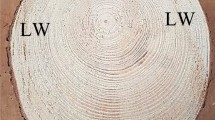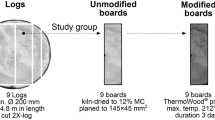Pinus radiata
D. Don) was examined for the occurrence of crook, bow and twist, and divided into two categories of samples, those with severe distortion, and those with negligible distortion. Ten samples in each category were examined. Small sections of window frame were extracted from the affected areas of the samples in the case of timber showing distortion, and at random for the control samples. Compression wood was assessed by image analysis from scanned images of the end grain, to give a percentage value. Each growth ring was examined microscopically to determine the severity of the compression wood if present and to determine the average microfibril angle in each ring. The microfibril angle gradient across the timber was then calculated. Results indicated that compression wood percent and distribution, average microfibril angle, and microfibril angle gradient, had a significant influence on the occurrence of distortion in these samples. Samples showing distortion altogether had high levels of compression wood, high microfibril angles, or high compression wood or microfibril angle gradients. On average, samples with high levels of distortion had 15% visual compression wood, an average microfibril angle of 32°, and a microfibril angle gradient of 12°, compared to 7%, 24°, and 7°, respectively for the control samples. Compression wood, where present, was typically of the mild type with intercellular spaces and a highly lignified S2L region in the cell walls of tracheids. For the majority of samples identified as containing compression wood, a highly lignified S2L region in the cell wall was the only anatomical feature present. This suggests that abnormal cell wall chemistry may be a significant factor in determining the dimensional stability of sawn timber and remanufactured products.
Similar content being viewed by others
Author information
Authors and Affiliations
Rights and permissions
About this article
Cite this article
Donaldson, L., Turner, J. The influence of compression wood and microfibril angle on the occurrence of distortion in window frames made from radiata pine (Pinus radiata). Holz als Roh- und Werkstoff 59, 163–168 (2001). https://doi.org/10.1007/s001070100201
Issue Date:
DOI: https://doi.org/10.1007/s001070100201




